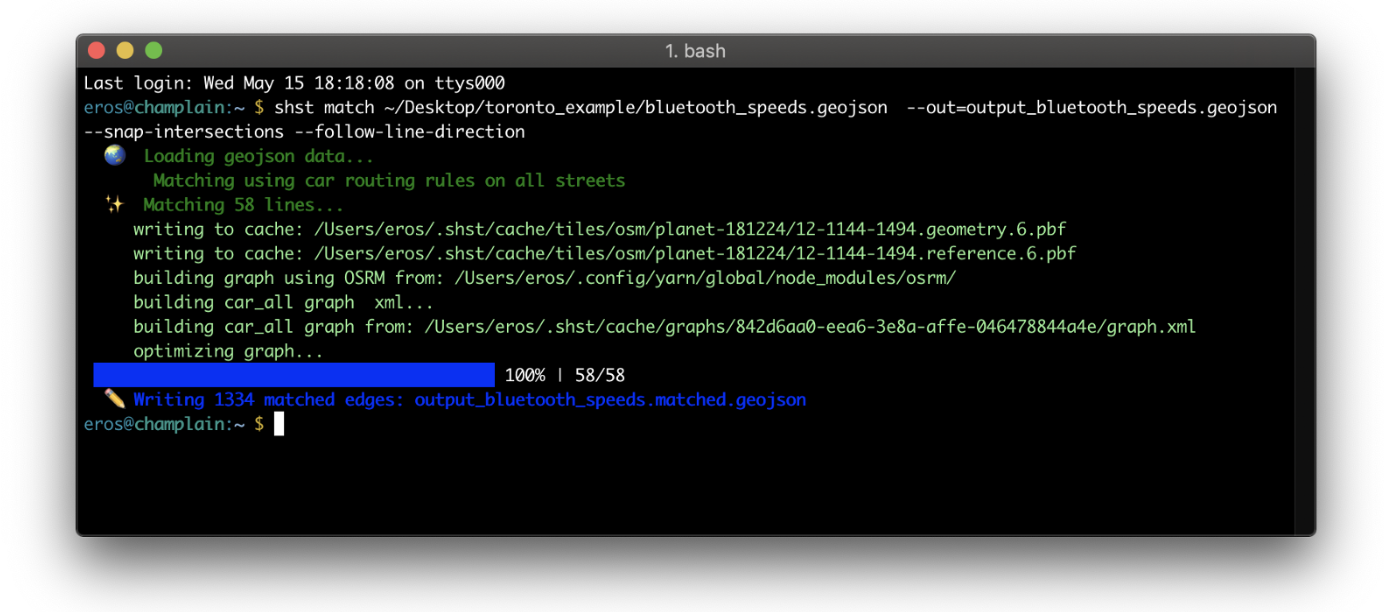SharedStreets (Node.js & JavaScript)
Node.js & JavaScript implementation of SharedStreets Reference System.
Command Line Interface (CLI)

Description
The CLI is the primary tool for users to match GIS data to SharedStreets. The CLI is installed and run locally. Compared to the hosted API, the CLI can process much larger datasets and runs more quickly.
The CLI is currently runs on macOS and Linux. It does not (yet) support Windows.
Usage:
shst <command> [options ... ]For detailed examples of how to use this tool, see the SharedStreets blog.
Install
The CLI requires Node v10+ on MacOS or Linux. Windows is not currently supported. On supported platforms it can be installed using either npm or yarn, or follow using Docker for unsupported environments.
NPM
To install using npm:
npm install -g sharedstreetsYarn
To install using yarn:
yarn global add sharedstreetsThis will install the CLI as shst.
Docker
To install using Docker create the following Dockerfile:
FROM node:11
ENV NPM_CONFIG_PREFIX=/home/node/.npm-global
ENV PATH=$PATH:/home/node/.npm-global/bin
USER node
RUN npm install -g sharedstreets
Docker image build:
docker build --tag shst-image .
Run match on local data file:
docker run -it -v [/path/to/data/on/host/]:/data/ --rm shst-image shst match /data/[input_file.geojson] --out=/data/output.geojson
Available commands
Available commands include:
- extract: extracts SharedStreets streets using polygon boundary and returns GeoJSON output of all intersecting features (this includes features that are in but not fully contained by the polygon)
- help: displays help for
shst - match: matches point and line features to SharedStreets references
extract
Extracts SharedStreets streets using polygon boundary and returns GeoJSON routput of all intersecting features from the SharedStreets reference tile set.
The input polygon(s) must be in GeoJSON format, using the WGS84 datum (EPSG:4326) in decimal degrees. "Extracts" includes features that are inside but not fully contained by the polygon.
Output is given as a GeoJSON file:
[output filename].geojson: contains features that intersected with the input polygon, including the SharedStreets ReferenceID
Usage:
shst extract <path/to/input_polygon.geojson> [options]help
Displays help for shst
Usage:
shst helpOptions:
The following options may be appended to the command:
- -h, --help: displays help for the
intersectscommand - -o, --out=[filename.geojson]: names the output file and allows user to place it in a different location
- -s, --stats: not sure
Example:
shst extract ~/Desktop/project/city_boundary.geojson --out=streets_in_city.geojsonmatch
Matches point and line features, from GIS, to SharedStreets references. This can be used to match city centerlines, parking meters, and other street features. Input data must be in GeoJSON format, using the WGS84 datum (EPSG:4326) in decimal degrees. Any standard GIS program (e.g. ArcGIS, QGIS) can convert from more common GIS file formats, like shapefile and geodatabase, into GeoJSON.
Output is given as up to three GeoJSON files:
[output filename].matched.geojson: contains features that matched, including the SharedStreets IDs and properties, as well as the original properties of the matched features (by default)[output filename].unmatched.geojson: contains any unmatched features, if applicable[output filename].invalid.geojson: contains any invalid input data, if applicable
Usage:
shst match <path/to/input_data.geojson> [options]Options:
Additional options allow users to change the modality for matching, incorporate a city's directionality information to support better matching, snap or offset results, cluster points along a street section, etc.
The following options may be appended to the command:
- -h, --help: displays help for the
intersectscommand - -o, --out=[filename.geojson]: names the output file and allows user to place it in a different location
- -p, --skip-port-properties: do not port input feature properties into the matched output (these are output fields normally preceeded by "pp_")
- --bearing-field=[bearing field]: [default: bearing] name of optional point property containing bearing in decimal degrees. If converting from GIS, this is the name of the appropriate field in the attribute table. Example:
--bearing-field=degrees. - --best-direction: only match one direction, based on best score
- --cluster-points=[number of meters]: target sub-segment length for clustering points (in meters). Since road segments will rarely divide evenly into the target length, actual lengths may vary slightly from the target.
- --direction-field=[direction field]: name of optional line property describing segment directionality. Use in conjunction with the related
one-way-*-valueandtwo-way-valueproperties - --follow-line-direction: only match using line direction
- --left-side-driving: directionality assumes left-side driving
- --match-bike: match using bike routing rules in OSRM, which excludes motorways and includes features like off-street paths
- --match-car: matching will use car routing rules in OSRM
- --match-motorway-only: only match against motorway segments
- --match-pedestrian: match using pedestrian routing rules
- --match-surface-streets-only: only match against surface street segments
- --offset-line=[offset in meters]: offset geometry based on direction of matched line (in meters). This visually offsets the result to make it easier to see on a map (for example, could be used for sidewalks and curbs).
- --one-way-against-direction-value=[one-way-against-direction value]: name of optional value of
direction-fieldindicating a one-way street against line direction - --one-way-with-direction-value=one-way-with-direction value: name of optional value of
direction-fieldindicating a one-way street with line direction - --search-radius=[number of meters]: [default: 10] the search radius, in meters, for snapping points, lines, and traces to the street
- --snap-intersections: snap line end-points to nearest intersection
- --snap-side-of-street: snap line to side of street
- --tile-hierarchy=[number]: [default: 6] SharedStreets tile hierarchy, which refers to the OSM data model. Level 6 includes unclassified roads and above. Level 7 includes service roads and above. Level 8 includes other features, like bike and pedestrian paths.
- --tile-source=[osm/planet-DATE]: [default: osm/planet-181224] SharedStreets tile source, which is derived from OSM at the date specified (in
yymmddformat). A new tile source is created roughly once a month and a list can be found here. - --two-way-value=[two-way-value]: name of optional value of
direction-fieldindicating a two-way street
Examples:
Matching city centerlines to SharedStreets:
$ shst match ~/Desktop/project/city_centerlines.geojson --out=city_centerlines.geojsonMatching city bike facilities to SharedStreets:
$ shst match ~/Desktop/project/city_bikeways.geojson --out=city_bikeways.geojson --match-bike --tile-hierarchy=8Development
For developers:
Install
git clone https://github.com/sharedstreets/sharedstreets-js.gityarn installyarn prepackyarn global add /Users/username/github/sharedstreets-jsTest
You can test your installation using the following:
yarn testTroubleshooting
- When updating
sharedstreets-js, remove the cache of graphs and data that were created using previous versions. Do this by deleting the entiresharedstreets-js/shstdirectory.
Build docs
yarn run docsBenchmark
yarn run bench